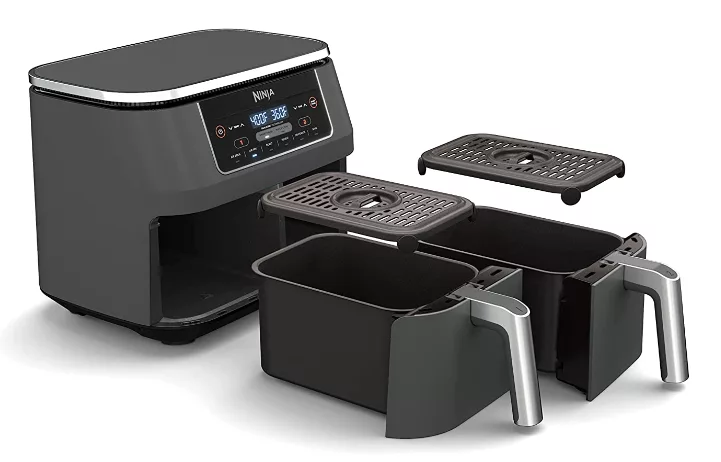
Ultimate Guide to Air Fryer Seasonings
The secret to creating delicious air fryer dishes lies not only in the cooking method but also in the seasonings you use. This in-depth guide will give you everything you need to succeed. A thoughtful combination of spices can elevate your air-fried meals to new heights, giving your food that mouthwatering, crave-worthy flavor. In this ultimate guide to air fryer seasonings, we’ll discuss the differences between warm and cool spices, explore some amazing Middle Eastern spices, and share tips for seasoning your air-fried fries and air-fried zucchini to perfection. So, let’s dive in and start spicing up your air fryer game!

Understanding Warm and Cool Spices
Spices can be broadly categorized into two groups: warm spices and cool spices. This distinction is based on the flavor profiles of the spices and their impact on the overall taste of a dish.
Warm spices, as the name suggests, provide a warm, rich, and comforting flavor to your dishes. They often have a sweet or slightly pungent taste and are commonly used in winter dishes, baked goods, and hearty meals. Examples of warm spices include cinnamon, nutmeg, cloves, allspice, and ginger.
Cool spices, on the other hand, provide a bright, refreshing, and uplifting flavor to your dishes. They often have a slightly bitter or tangy taste and are commonly used in summer dishes, salads, and lighter meals. Examples of cool spices include mint, coriander, fennel seeds, and dill.
When seasoning your air-fried dishes, consider the balance of warm and cool spices to create a harmonious and well-rounded flavor profile. The key is experimenting with different combinations to find the perfect blend that suits your taste buds.

Exploring Middle Eastern Spices
Middle Eastern cuisine is known for its bold and diverse flavors, thanks to the use of various unique spices. Here are some standout Middle Eastern spices that you can use to elevate your air-fried dishes:
- Cumin: Cumin is a warm spice with a slightly earthy and bitter flavor. It’s commonly used in Middle Eastern, Indian, and Mexican cuisines and is a key ingredient in spice blends like garam masala and taco seasoning. Cumin pairs well with vegetables, meats, and legumes.
- Shawarma: Shawarma is a Middle Eastern spice blend typically used to season grilled meats. It usually contains a mix of warm spices like cumin, coriander, paprika, turmeric, and cinnamon, along with garlic powder, onion powder, and other herbs. Shawarma seasoning can also be used to flavor vegetables, rice, and other dishes in your air fryer.
- Sumac: Sumac is a tangy, slightly tart spice that adds a vibrant, citrusy flavor to your dishes. It’s commonly used in Middle Eastern cooking as a seasoning for salads, grilled meats, and rice dishes. In your air fryer, try sprinkling sumac on vegetables, fish, or chicken for a refreshing twist.
- Za’atar: Za’atar is a Middle Eastern spice blend that combines thyme, sumac, sesame seeds, and other herbs. It has a nutty, tangy, and slightly earthy flavor that works well with various dishes. Use za’atar as a seasoning for air-fried vegetables, and meats, or even as a topping for flatbreads and dips.

Steak Seasonings for Veggies
Steak seasonings are a blend of spices like garlic powder, salt, paprika, and black pepper, making them great for vegetables. The bold flavors of steak seasonings can add depth and complexity to your veggies without overpowering or oversalting them.
Try using a dash of steak seasoning on air-fried fries, mushrooms, brussels sprouts, zucchini, bell peppers, or even cauliflower for a delicious and satisfying side dish.
The Versatility of Taco Seasoning and Cumin
Taco seasoning and cumin are versatile spices that can add a burst of flavor to a wide range of dishes. The combination of earthy cumin, zesty chili powder, and aromatic oregano found in taco seasoning makes it an excellent choice. Try using a dash of taco seasoning on air-fried chicken, shrimp, or potato fries for a twist.
Cumin, as mentioned earlier, is a warm spice with an earthy and slightly bitter flavor. It’s a key ingredient in many spice blends and is particularly well-suited to air-fried dishes. Cumin’s flavor profile makes it a fantastic addition to dishes like air-fried chickpeas, roasted vegetables, and marinated meats.
The Art of Balancing Spices
When seasoning your air-fried dishes, it’s essential to strike the right balance between flavors. Overdoing it with spices can lead to an overpowering taste, while under-seasoning can result in a bland and unexciting dish.
Here are some tips to help you find the perfect balance:
- Taste test: If you’re unsure about the flavor of a particular spice or how much to use, try tasting a small amount on its own to get a sense of its potency. This will help you gauge how much to add to your dish.
- Start small: When experimenting with new spices or blends, start with a small amount and gradually build up the flavor. This approach allows you to fine-tune the seasoning to your liking without overdoing it.
- Follow a recipe: If you’re new to using spices or unsure about the right combination, follow a trusted recipe to get started. As you become more comfortable with the flavors and proportions, you can begin to adjust the seasoning to suit your taste preferences.
- Trust your instincts: As you become more familiar with various spices and their flavors, trust your instincts when seasoning your dishes. Your taste buds are the best guide to creating a well-balanced and delicious meal.

Seasoning Tips for Air Fryer Cooking
When seasoning your air-fried dishes, follow these simple steps to ensure an even and flavorful coating:
- Add food to the air fryer basket first: Before adding any seasonings or oil, place your food items in the air fryer basket to gauge the amount of space and the best arrangement for even cooking.
- Drizzle with neutral oil: Using a bottle with an oil spout, give your food items three good flicks of neutral oil, such as vegetable or canola oil. This will help the spices adhere to the food and promote even cooking.
- Sprinkle on the spice mix: With your food and oil in place, sprinkle your chosen spice mix over the items in the basket. Be sure to distribute the spices evenly for a consistent flavor throughout.
- Toss or jiggle the basket: Gently toss or jiggle the air fryer basket to ensure the oil and spices coat the food items evenly. This will help to create a uniform flavor and texture in your finished dish.
Experimenting with spices is one of the best ways to elevate your air-fried dishes. By exploring the world of Middle Eastern seasonings and mastering the art of balancing flavors, you’ll be well on your way to creating air fryer meals that are both delicious and memorable.
Want some inspiration?
Check out our recipe for Chicken Drumsticks, Potato Fries, Zucchini Fries, Fried eggs, and more!








